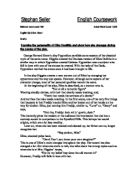Pygmalion – report
The class structure in Victorian England was based upon the extremes of wealth and poverty, virtue and crime, and privilege and exploitation. The strict hierarchy began at the very peak with the Monarch (queen empress Victoria), followed by those with titles; royal dukes, non-royal dukes, earls, viscounts, barons, baronets, knights and the broad range of gentry who possessed no titles but were wealthy. From there came army officers, vicars or parsons of Church of England, university professors, lawyers, and doctors. In their own scale, those at the upper end had title relatives; the lower had connections with mercantile classes. All of the above, created only 2% of the population, yet held most of England’s wealth. The other 98% had no position in society or any equality of status among them. The hierarchy, which went through their society, held the newly arrived and disadvantaged at the lowest end of the scale with the ‘working classes’ above them. For these workers, their name described their function. The highest of these merged into the middle class, which is hard to define. So overall, the there became three distinct classes - the and , the class, and the







